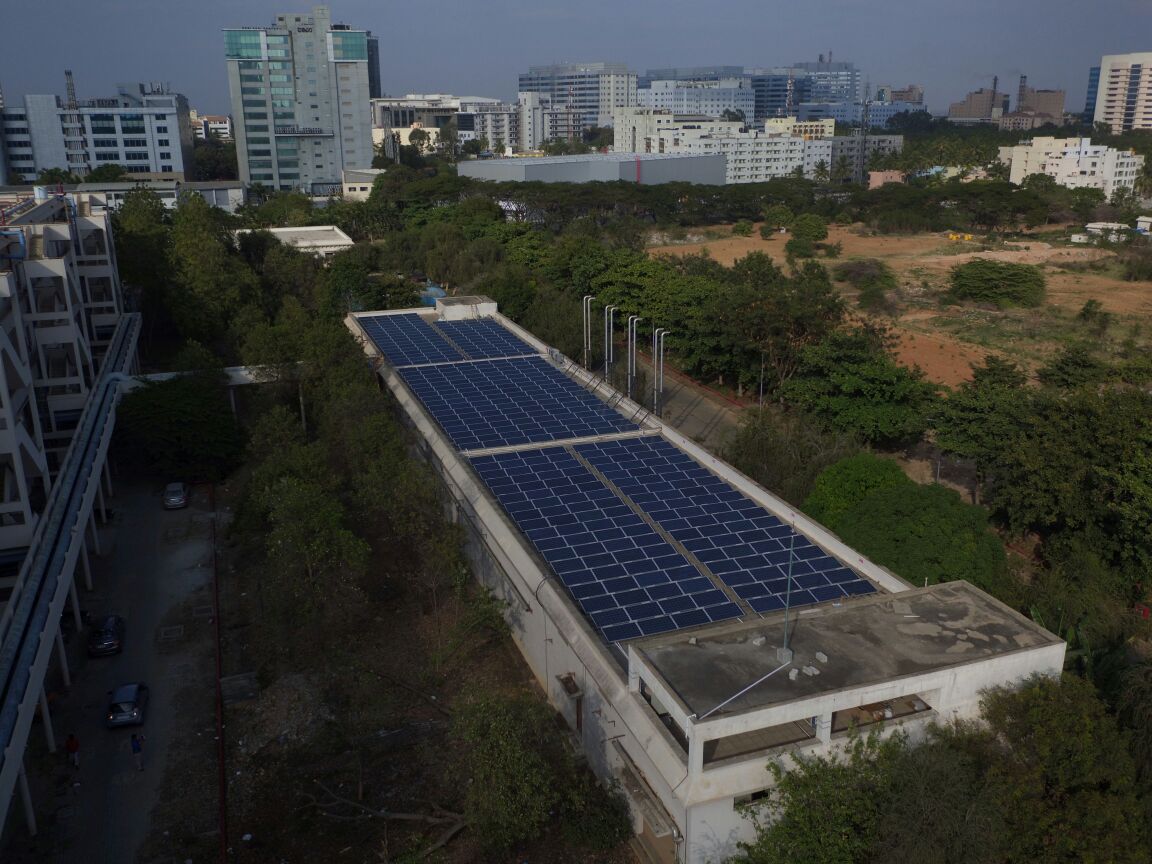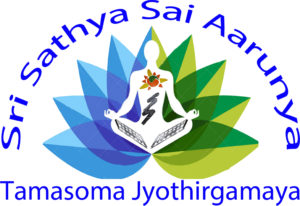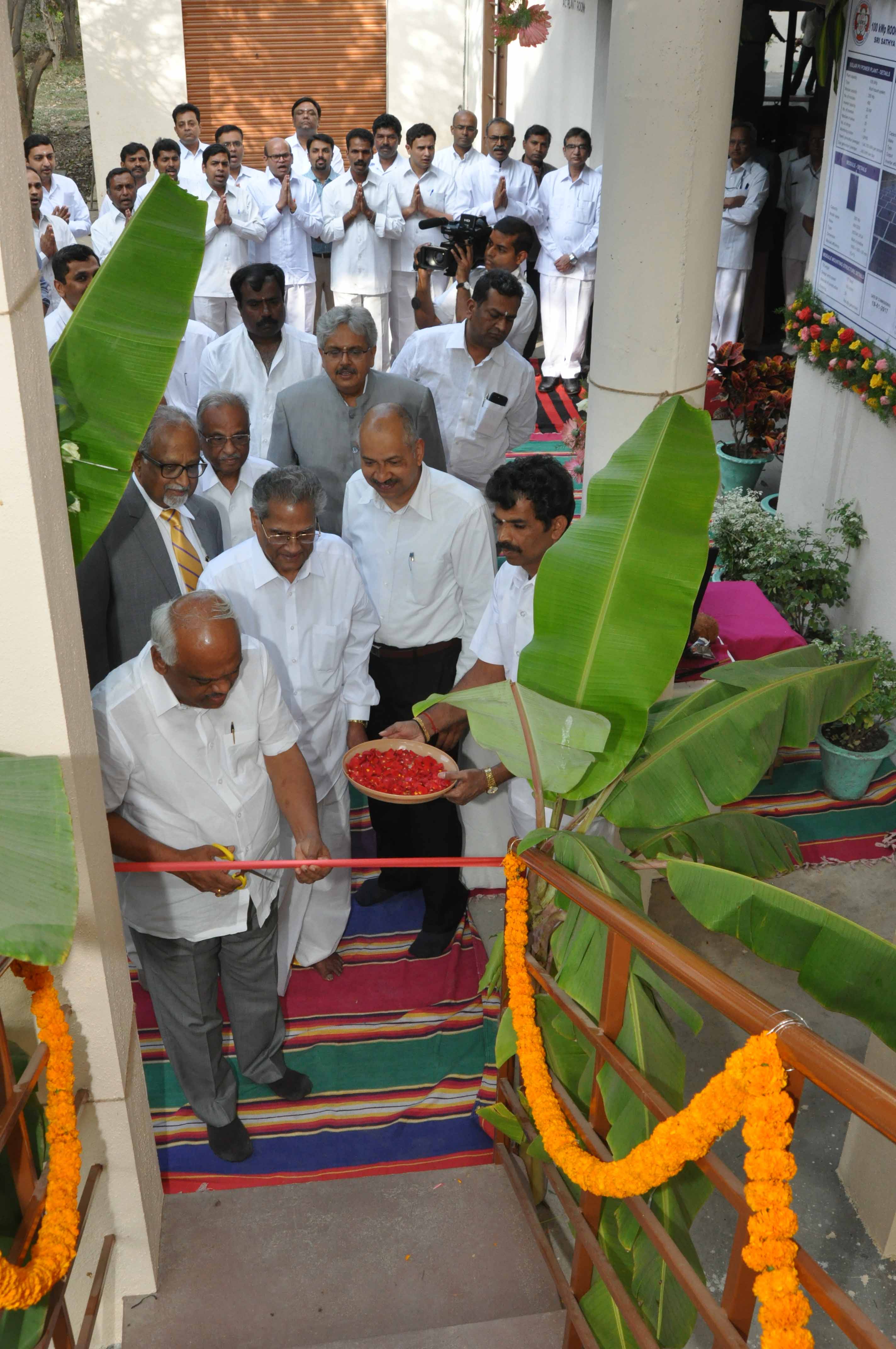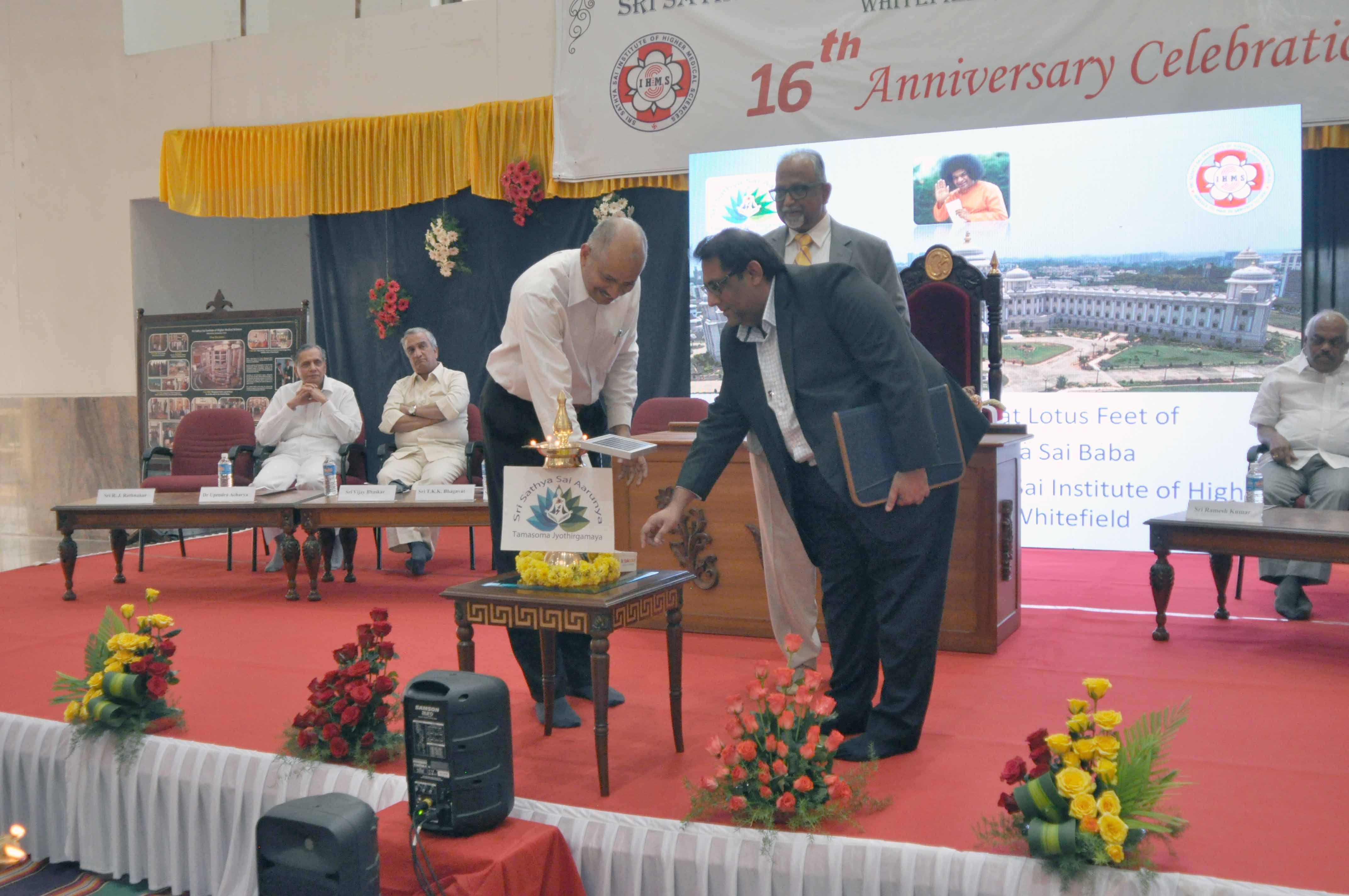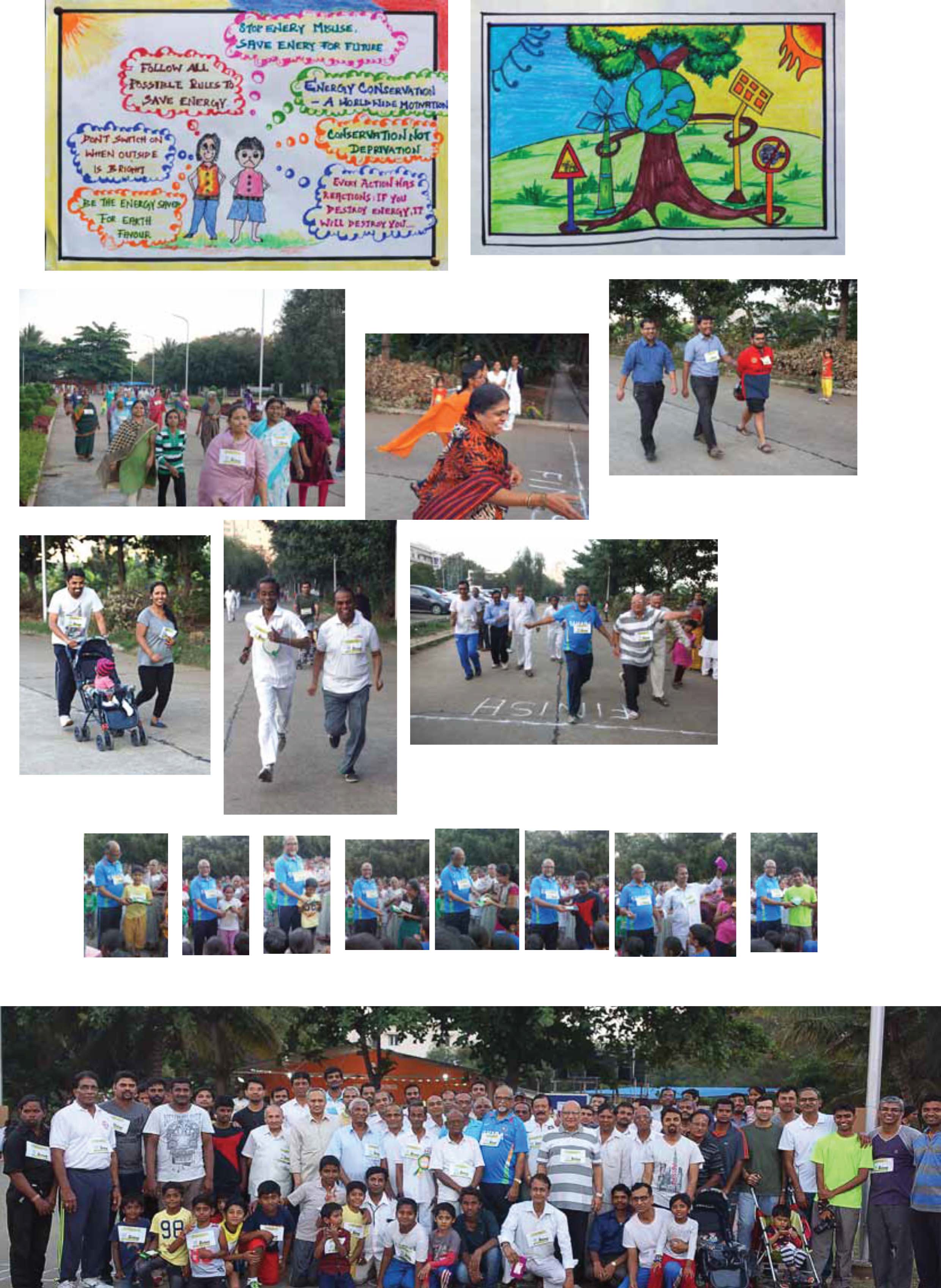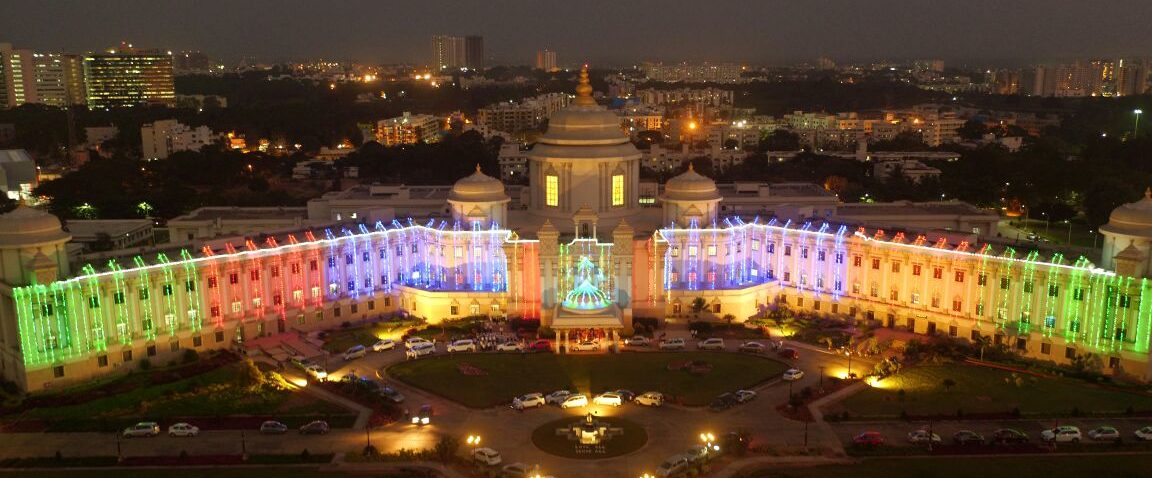19-Jan-2017 stands out as a red-letter day in the annals of Sri Sathya Sai Institute of Higher Medical Sciences (SSSIHMS),
as on this day, the Institute, and the Sri Sathya Sai Central Trust (SSSCT), have taken their first a proud and responsible step forward towards investing in green energy by commissioning a 100 kWp roof-top, Grid-Integrated Solar Power Plant.
The Hon’ble Minister of Health, Govt. of Karnataka, Sri K.R. Ramesh Kumar, commissioned the plant on the occasion of the 16th Anniversary of the Institute. The Trustees of SSSCT, Dr. Sundaresh, Director, SSSIHMS- Whitefield & Dr. Upendra Acharya, MS, SSSGH-WFD and officials from Kotak Urja Pvt. Ltd., who supplied and installed the plant were also present.
The plant has been christened as “Sri Sathya Sai Aarunya”. Shri P. Ravi Kumar, I.A.S, Addl. Chief Secretary, Dept. of Energy, turned on the switch to turn on a traditional lamp in the dome area, lit by LEDs, and powered by solar power to symbolically commission the plant. He also appreciated the initiative of the Trust to reduce the green-house gas emission, and of going green by inaugurating the 100 kW solar plant on the occasion of the Institute’s 16th Anniversary.
This step makes SSSIHMS, Whitefield a completely free super-specialty hospital, the first free hospital in Bangalore, and perhaps the whole of Karnataka, to set up a pilot solar PV plant of this size. The participants inspected the facility and Dr. B. Raghavendra Prasad, Professor, Indian Institute of Astrophysics and a Consultant to the Trust for this project briefed them on the salient features of the plant.This is the first initiative by the Sri Sathya Sai Central Trust and represents their keenness in furthering the cause of green energy, and reducing one’s carbon foot-print. Basing on the experience with this plant, it is proposed to scale up the capacity of the plant at SSSIHMS-Whitefield and set up similar units in other institutions of the Trust.
The 100 kWp plant is made up of 400 nos. multi-crystalline solar photo-voltaic panels, each of 250 W capacity. The panels are inter-connected together in strings of 20 panels each. Each of the strings is connected to one inverter of 20 kW capacity. The output of the plant is connected to the hospital supply, through a bi-directional meter. The output can be monitored remotely through the Internet.
Along with the above, as a means to create awareness amongst staff and their families regarding the usage of power, an Energy Conservation drive was initiated at SSSIHMS. This was kick-started on 23-Dec-2016, when the Director led more than 200 staff and family members, including children in taking a pledge to reduce energy wastage and minimize use of electricity. Doctors, nurses, technicians, and support staff all joined hands and ran / walked 3 km around the hospital to create awareness about energy conservation.
Separately, a poster competition was also held, and it was gratifying to see the creative talents of staff and their family members showcased in the dome area of the Hospital. The first prize for the poster competition for adults was bagged by Ms. Sai Janani and the second prize was shared by Dr. Sanyogita and V. Sathya Sai Priyanka. The first prize for the poster competition for children was bagged by Shashank Selvakumar and the second prize won by team of Yasmitha, Sai Amritha and Sowshelya. The prize for creating the logo for the solar power plant was shared by Dr. Prayaag Kini and Dr. Yatindra Ashtaputre.
Energy Saving Journey So Far…
To provide the highest standards of quality of care to the patients, there is a significantly high consumption of energy in any hospital, but Institute has been looking at avenues
to optimize energy usage, without compromising on the quality of care. During the last year, thanks to the generosity of InstaPower Ltd., the Institute has changed over to 25 watt LED street-lights from 150 watt sodium vapour lights, reducing the power consumption by five times. LED tube- lights have been installed in 24×7 use locations, and more such replacements are being planned in a phased manner. Also, modifications have been made in the air-conditioning system to re-circulate cooled and filtered air in the ICUs and a few OTs, to reduce power consumption. Apart from these, studies are being to look into the use of variable frequency drives to optimize the power consumption in the air-handling units.
Power Consumption at Sssihms
SSSIHMS, Bangalore has an annual power requirement of 36 lakh units of power every year. Since the inception of the Hospital in 2001, the Karnataka Government has been allocating Rs. 2 crore power subsidy per annum towards energy consumed at the Hospital and BESCOM generates bills every month, basing on the presently applicable tariff.
While the overall energy consumption pattern of SSSIHMS over the years has remained constant, the power tariff has been increasing over the years, causing the energy bill to increase. Since 2011, the total of energy bills for the year exceeded the subsidy limit of Rs. 2 crore. In 2016, the Institute has paid Rs. 43 lakhs towards excess over the subsidy limit.
Efforts have been made to look at reducing energy consumption through avenues shown through energy
audits and also through alternate means of generating energy. Where practical, the recommendations of previous energy audits have been implemented, bringing down the consumption. On the energy supply front, amongst alternate means of generating energy, solar photo-voltaic (PV) systems stand out as a prominent choice, as they are clean sources of power, and sun-light is available in abundance and they have a long life of 25 years and beyond.
Economics of Solar Power Plants
Dr. B. Raghavendra Prasad, Professor at the Indian Institute of Astrophysics, an alumnus of Sri Sathya Sai Institute of Higher Learning, and a person with significant experience in the area of solar PV power generation, conducted a feasibility study before the Trust invested in this project.
He proposed that, SSSIHMS-WFD could set up a 100 KWp (kilo-watt peak) roof-top solar power plant as a pilot project, which would generate up to 1.5 lakh units of energy per annum (5% of the hospital’s per annum requirement, and 30% of the subsidy shortfall). Considering the present rate of Rs.6.5 per kWH, and cost of Rs. 58 lakhs towards a 100 kWp power plant, the pay-back period for the investment would be 7 years on cost-to-cost basis & 9 years as per net-present- value (NPV).
To promote investment in this clean technology, there is a 15% subsidy on the value of the project, being offered by MNRE (Ministry of New & Renewable Energy).
There is adequate roof area available at SSSIHMS-WFD & ancillary buildings, almost to an extent of 1.5 lakh SFT (14,300 sq.m). Considering the nearness to the electrical infrastructure, it is proposed to install the solar PV system on the service block of the Hospital, with a terrace area of 15,000 sft, adequate to set up the 100 kWp solar PV power plant.
It was decided to go in for a grid-connected system under
a net-metering scheme, wherein, we could technically sell excess power to BESCOM. Also, we would be registered with BESCOM, as an institutional generator of solar power. No power storage solution (batteries) was considered, as it is expected the power generated from the plant would be utilized immediately upon generation. Batteries would also mean higher initial costs and also replacement costs every 4-5 years.
Solar PV systems are known to be rugged, with no moving parts and requiring little maintenance. The sub-systems like the inverters are designed for long-life of 15 years and beyond. The only maintenance needed to improve power generation is to carry out periodic cleaning of the panels.

